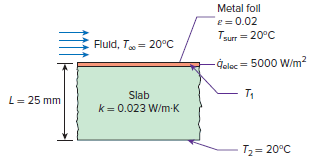In an experiment to measure convection heat transfer coefficients, a very thin metal foil of very low
Question:
(a) The convection heat transfer coefficient if air is flowing over the metal foil and the surface temperature of the foil is 150°C;
(b) The convection heat transfer coefficient if water is flowing over the metal foil and the surface temperature of the foil is 30°C.

Fantastic news! We've Found the answer you've been seeking!
Step by Step Answer:
Related Book For 

Fundamentals of Thermal-Fluid Sciences
ISBN: 978-0078027680
5th edition
Authors: Yunus A. Cengel, Robert H. Turner, John M. Cimbala
Question Posted:





